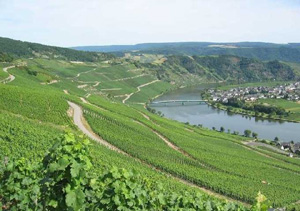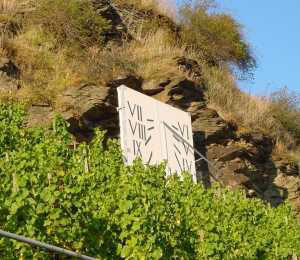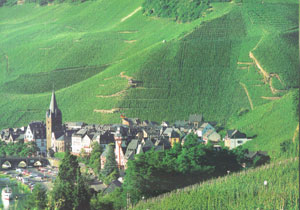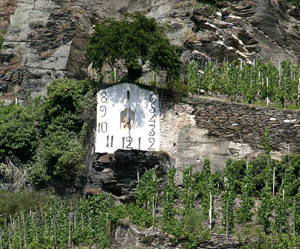
Piesport
Throughout the centuries, the steep slopes across the river from the town of Piesport have enjoyed a reputation of having among the best vineyards on the Mosel River. Today the Piesporter Goldtröpfchen (Goldtröpfchen = little drops of Piesport gold); vineyard consists of 166.8 acres. The Piesporter Domherr (Domherr = Bishop) vineyard consists of 12 acres and basks in warm sunlight both from above and reflected off the river below. By virtue of this double warming effect, the Devonian slate soil absorbs a tremendous amount of solar energy during the day, which is then gradually released to the vines throughout the night. The fruity Goldtröpfchen and Domherr wines are distinguished by their black currant fruit character, as well as an ever-present minerality.
|

Brauneberg
Brauneberg's Juffer-Sonnenuhr (pronounced YOU-fer = Old Maid, ZON-en-ooer = Sundial) has south-facing slopes with an inclination of up to 70% and, is planted with about 104 acres of vines. Some vineyards have a south-southeast or south-southwest exposure due to slight depressions and elevations on the surface of the hill. There is a large concave pocket that captures the rays of the sun from every angle of incidence. The site consists of deep, weathered soils with a high proportion of stones. Ultimately, the filigree structure of the wines, with their pronounced mineral tone and wealth of aromas, often reminiscent of exotic fruits, is shaped by this microclimate. The proximity of the Mosel River and the steep, rocky cliffs overlooking the site also increase the amount of sunlight absorbed and reflected.
|

Bernkastel
The Mosel Valley is among the most important wine-producing regions of the world. At its center is Bernkastel, the best slopes of which include the sector known as the Badstube (spa). All the prime vineyards of this picturesque wine town are within the Badstube. Vineyards facing directly south yield some of the greatest wine from the Mosel valley, year after year. The Graben (Graben = ditch) and Lay (pronounced LIE, an old Mosel word for slate) are the neighboring vineyards of the Bernkasteler Doctor, which are only planted with Riesling vines. The soil consists of Devonian slate providing the wines with the characteristic minerality. All these vineyards are in south-facing locations and on steep terraces, which do not permit the use of any field machinery. Many parcels still have ungrafted 100-year-old vines and through additional reduction of buds per vine, yields are kept low and grapes are sorted several times to ensure quality. The resulting Riesling wines, rich in mineral extracts, tempt the wine connoisseur with their class, their elegance and a fine balance of fruitiness and lively acidity. The name Badstube originates from a former hot spring that in the Middle Ages heated a kind of health spa. Today the name is synonymous with great wines.
|

Graach
Three kilometers downriver from the bustling tourist town of Bernkastel lies one of the top vineyard sites on the Mosel. The Graacher Himmelreich (pronounced Him-mel-rike = Kingdom of Heaven) reflects the historic engagement of the churches in wine production, with holdings in the best locations. Associations to the excellence of Riesling wines named "Himmelreich" are allowed; after all, they taste heavenly. Steep south-southwest facing slopes with weathered slate soil receive plenty of sun and warmth. Vines rooting down some 98.5 feet have access to water sources in parts of the hillside, helping them even through prolonged draught periods. Moderate low yields from ungrafted vines up to 100 years old result in the high class Graacher wines with concentrated fruit, intense mineral texture and lingering finish typical for the Middle Mosel and worthy to be considered among the Mosel's best.
|

Wehlen
The famous "Wehlener Sonnenuhr", pronounced VAY-len-er ZON-en-ooer (Sonnenuhr = sundial) vineyard facing the small town of Wehlen across the Mosel produces very full-bodied, luscious wines. Although it is a vineyard of 165 acres, the individual holdings are fairly small. The Sonnenuhr vineyard faces south-southwest. It is located in the middle of a long, steep, curved slate slope on the Mosel, which stretches five kilometers from Bernkastel to Zeltingen. This precipitously steep, rocky vineyard yields some of the most elegant and sophisticated white wines in the world. The stony gray slate soil gives the wine a delicate and crisp acidity that perfectly balances the pure peachy fruit. The precious wines from the Sonnenuhr vineyard led to a solid regional economic foundation. In the early days of this century the citizens of Wehlen were able to build a suspension bridge, which is today a historic monument and alone with the sundial, a local landmark.
|